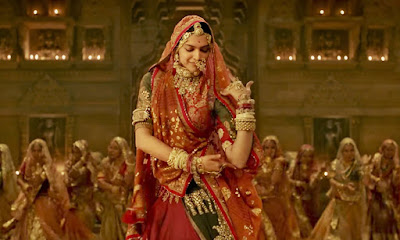Irrespective of the controversies, Padmaavat had a rocking trailer, showcasing glimpses of Sanjay Leela Bhansali’s flair for detailing and sheer beauty. In a kind of anti-climax, for all the barbaric protests that arose, to the point of beheading threats, that the movie doesn’t honour Rajputs. On the contrary, the movie kind of goes overboard with Rajputs, their honour, their bravery and never-say-die attitude.
Bhansali does the classic director’s imbalance. He leans towards the villain (Ranveer Singh) more, giving the character more dynamism and contrasts. In comparison, Raja Ratan Singh (Shahid Kapoor) comes off second. There is less time and screenwriting spend on him, and it shows. Also there seems to be a kind of filmmaking diplomacy in showing the two male stars at par. The climatic sword fight between Shahid and Ranveer is so calculated and guarded, that it seems two stars fighting not characters.
Also, those who are expecting an out-and-out action drama, this is not it. Bhansali’s strength is drama, and he sticks to it. The soundtrack, again by Bhansali, is the movie’s strength.
After finally catching up with the film, a lot of things stuck out for me:
Rajputs as Heroes, Khiljis as Villians
Did Bhansali change the screenplay after the initial protests? The way Rajputs are praised sky high in Padmaavat, you may well believe that Bhansali will join the Karni Sena soon. Contrast it with Khiljis depicted as savage, dishonorable, uncultured and power-hungry. It’s a Ram vs Raavan fight, as Padmavati (Deepika Padukone), is made to say in the film.
Star Power Over Story
Clearly, attempts have been made to balance Shahid Kapoor’s and Ranveer Singh’s star power, at the expense of story and logic. How else do you explain Alauddin Khilji walking in alone into Chittor, making an atrocious demand and still getting away unhurt? How about Ratan Singh citing honor as a reason to return the favor and visit Alauddin’s tent unarmed?
That an escaping king would find time to taunt his tormentor before escaping in elaborate exchange of dialogues is hard to believe. The final sword fight is almost a lazy skirmish, but for some moments. It is a Shahid-Ranveer compensatory fight rather than a Rajput-Khilji faceoff. These clearly compensated elements cut off any chances of a fine film.
Padmavati Appears and Disappears
This was supposed to be Padmavati’s film, right? But for the final 15 minutes, we get little of Deepika Padukone. She is resplendent at the start, followed by the decorous Ghoomar song sequence, and is then reduced to giving Shahid Kapoor loving, faithful glances. We have no hint at Ratan Singh’s journey either.
Alauddin Khilji (Ranveer Singh) is the only character with an elaborate backstory. We clearly see where he is coming from, unlike Ratan Singh and Padmavati. Add to that Ranveer’s madcap performance, no wonder Alauddin’s deplorable, menacing character engages and connects to a greater degree.
Mass Suicide as a Brave Act?
I was stunned by the final mass self-immolation scene. In the context of the movie, it is heart-rending. But as we see Padmavati stepping into the CGI-created flames with a smile, the modern context to it is alarming. So, if all your men are all dead and the enemies are sure to ravish you, the only way out for women is suicide? Mixed, dubious signals here.
The Final Question
So, did Bhansali make major changes to the story and the approach after the initial protests? What role did the mass coercion and Karni Sena threat play in making Padmaavat a lesser movie? We can only wait for the filmmakers to speak out some day in our so-called democratic country.
